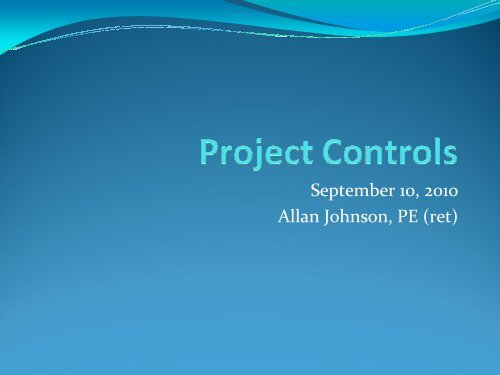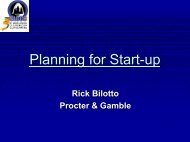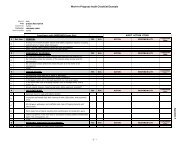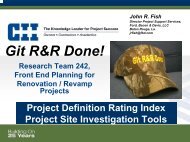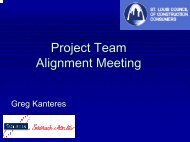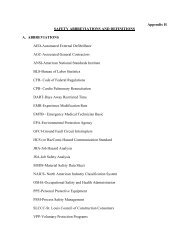Johnson - Project Controls - CII Overview
Johnson - Project Controls - CII Overview
Johnson - Project Controls - CII Overview
You also want an ePaper? Increase the reach of your titles
YUMPU automatically turns print PDFs into web optimized ePapers that Google loves.
September 10, 2010<br />
Allan <strong>Johnson</strong>, PE (ret)
Outline<br />
• <strong>Overview</strong><br />
• Key Definitions<br />
• Phases of <strong>Project</strong><br />
• Keys to <strong>Project</strong> Control<br />
• Change Management<br />
• <strong>CII</strong> Resources
<strong>Project</strong> Success<br />
•Meet <strong>Project</strong> Goals:<br />
• Budget<br />
• Schedule<br />
• Safety<br />
• Quality (functionality)<br />
• Business Case
<strong>Project</strong> Priorities<br />
•Cost<br />
•Schedule<br />
•Capability<br />
(<strong>CII</strong> – IR 204‐2 <strong>Project</strong> Priority Calculator)<br />
(<strong>CII</strong> – RS 214‐1 Trade‐off between Cost & Schedule)
Work Your Plan
Create Standard<br />
Template<br />
<strong>Project</strong> Teams<br />
Define Scope
Key Definitions:<br />
• A Work Breakdown Structure (WBS) is the<br />
hierarchical representation of a complete project<br />
or program, its components being arrayed in ever<br />
increasing detail.<br />
• A WBS Element is a component at any level on a<br />
WBS.<br />
• A Cost Breakdown Structure (CBS) is the<br />
hierarchical representation of all cost accounts in<br />
a project to include indirects and overhead. The<br />
WBS is included within the CBS.
Key Definitions:<br />
• A Work Package is a well‐defined scope of work<br />
that terminates in a deliverable product(s) or<br />
completion of a service.<br />
(<strong>CII</strong> – 6‐6 Work Packaging for <strong>Project</strong> Control)<br />
• A Task is an operation performed by an<br />
individual, crew(s), and/or equipment, such<br />
operation being directly or indirectly required for<br />
completion of a work package.
Key Definitions:<br />
• Control Accounts are selected accounts used by<br />
managers as the basis for resource allocation,<br />
productivity management, and/or data collection<br />
for the historical.<br />
• Activities are associated with the scheduling<br />
function and refer to the work represented by<br />
arrows on a arrow‐diagram‐method (ADM)<br />
critical path format schedule. An activity can be a<br />
task on a detailed schedule or a work package on<br />
a more summary schedule.
Key Definitions:<br />
• Scope Definition is the key starting point in any<br />
project.<br />
(<strong>CII</strong> – 6‐2 Scope Definition and Control)<br />
(<strong>CII</strong> ‐ 113‐2 <strong>Project</strong> Definition Rating Index (PDRI) –<br />
Industrial <strong>Project</strong>s – including STAR Tool)<br />
(<strong>CII</strong> ‐ 155‐2 <strong>Project</strong> Definition Rating Index (PDRI) –<br />
Building <strong>Project</strong>s)
Phases of <strong>Project</strong><br />
•Planning<br />
•Engineering<br />
•Procurement<br />
•Construction<br />
•Startup<br />
•Closeout
Planning<br />
• Schedule<br />
• Budget<br />
• Deliverables
Engineering<br />
• Planned to meet needs of Procurement and<br />
Construction<br />
• Determine packaging of engineering<br />
deliverables<br />
• Control scope
Engineering Percentage Completion<br />
• Start drafting 0%<br />
• Drawn, not checked 20%<br />
• Complete for office check 35%<br />
• To owner for approval 70%<br />
• First issue 95%<br />
• Final issue* 100%<br />
*Only when no additional engineering is<br />
anticipated
Procurement<br />
• Early involvement to identify suppliers<br />
• Secure equipment information to feed the<br />
engineering effort<br />
• Procure long lead items to meet schedule needs<br />
• Monitor and Expedite to meet schedule needs<br />
• Quality inspections –FAT, SAT<br />
• Material Management
Procurement Percentage Completion<br />
• Bidders list developed 5%<br />
• Inquiry documents complete 10%<br />
• Bids analyzed 20%<br />
• Contract awarded 25%<br />
• Vendor drawings submitted 45%<br />
• Vendor drawings approved 50%<br />
• Equipment shipped 90%<br />
• Equipment received 100%
Construction<br />
• Logistics and sequencing of activities is<br />
vital<br />
• Work Packaging<br />
• Physical progressing is key<br />
• Progress Payments
Startup<br />
• Start Planning begins early<br />
• Complex due to interdependencies of<br />
systems<br />
• Temporary Systems<br />
• Work Packaging
Closeout<br />
• Asset values set up for depreciation<br />
• Asset management setup<br />
• Data capture
Keys to <strong>Project</strong> Control<br />
• At the initiation of project create a<br />
schedule and control budget that aligns<br />
with the project execution plan.<br />
• Maintain a robust change management<br />
system.<br />
• Have a contingency management plan.
Keys to <strong>Project</strong> Control<br />
• Reassess progress and project events on a<br />
regular frequency and update forecasts.<br />
• Assess variation to the current budget and<br />
schedule to identify potential problems.<br />
• Plan and implement action to correct<br />
variations.
Control Schedule<br />
• Sample Control Schedule
Control Budget<br />
• Sample CBS WBS.xls
Progress Updates<br />
• Frequently Update & Report<br />
• Schedule<br />
• Actual compared to Baseline Schedule<br />
• Budget<br />
• Sample Progress Payment Continuation<br />
Sheet
Change Management<br />
• Scope Control is Vital!<br />
• Loss of scope control during engineering<br />
ranks second in terms of cost overruns<br />
• Cost impact of change is related to point in<br />
time<br />
(<strong>CII</strong> ‐ SP43‐1 — <strong>Project</strong> Change Management)
Keys to Change<br />
Management<br />
• Promote a balanced change culture<br />
• Encourage beneficial change<br />
• Prevent/Discourage detrimental change<br />
• Recognize change<br />
• Evaluate change<br />
• Implement change<br />
• Continuously improve from lessons learned
<strong>CII</strong> References<br />
• RS 6‐1 <strong>Project</strong> Control for Engineering<br />
• RS 6‐2 Scope Definition and Control<br />
• RS 6‐5 <strong>Project</strong> Control for Construction<br />
• RS 6‐6 Work Packaging for <strong>Project</strong> Control<br />
• SP43‐1 <strong>Project</strong> Change Management<br />
• RS 165‐1 Owner’s Tool for <strong>Project</strong> Delivery and Contract<br />
Strategy Selection<br />
• IR 121_2 Planning for Startup<br />
• RS 214‐1 Trade‐off between Cost & Schedule<br />
• SD 28 Work Packaging for <strong>Project</strong> Control<br />
• IR 204‐2 <strong>Project</strong> Priority Calculator<br />
• IR 113‐2 <strong>Project</strong> Definition Rating Index (PDRI) –Industrial<br />
<strong>Project</strong>s<br />
• IR 242‐2 STAR Tool (Shutdown/Turnaround Alignment Review)Shutdown<br />
Turnaround Alignment Review (STAR) Tool<br />
• IR 155‐2 <strong>Project</strong> Definition Rating Index (PDRI) –Building<br />
<strong>Project</strong>s


